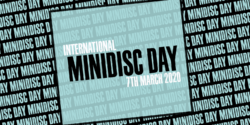As we enter our second decade of everything-digital-on-demand, the desire for tactile media only seems to grow new buds. By now the vinyl resurgence is old news, and while mainstream publications still gasp or tsk-tsk at the cassette revival, I think we can safely say the tape medium has retaken a beachhead, too.
Today is all about the minidisc. Quite literally, because it’s been declared International Minidisc Day.
Yet, even I, a longtime minidisc user and aficionado, find this new holiday a bit curious. Before I explain, a little history is in order.
Long a format of choice for grassroots and independent radio production, the humble minidisc bridged us from the end of tape days in the early 90s to the full maturation of solid-state digital audio recorders in the mid- to late-2000s. Sony, the format’s originator, imagined the little digital discs as an eventual replacement for the compact cassette. In 1992 this was a plausible proposition, because it offered near-CD quality digital recording in a smaller and more robust package. Sony – and a few other labels – even released several dozen pre-recorded minidiscs to provide an alternative to pre-recorded cassettes, already in steep decline.
But in the days before CD-Rs and iPods it was minidisc’s digital recording capability that was the real attraction. Due to that, MD did become a cassette replacement for millions of people around the world who recorded their own mix minidiscs or just dubbed over their CDs for more convenient listening on the go.
Even In its heyday of the 90s and 2000s minidisc never really took off as a medium for distributing music. I knew plenty of musicians and radio producers recording on the format, but the end products ended up on the radio, on CDs and eventually online.
This might seem odd, since independent musicians and labels distributed on cassettes from the 70s through to today, and once CD-Rs came down in price in the late 90s, they, too, spawned their own music underground. But not minidisc… at least not in the United States.
It’s true minidisc was never as popular in the U.S. as in Japan or the U.K., even though millions of recorders and players were sold here. It’s just that they never reached the kind of per capita penetration of cassettes, CDs or even 8-tracks. It seems to me that running a minidisc-only label even 2003 would have been just too limiting, though I don’t doubt that there must have been some limited or one-off releases.
Coming back to today, Minidisc Day, the funny thing is that the celebration is modeled after Record Store Day, in that record labels are releasing albums on minidisc today. However, unlike Record Store Day, there are no actual brick-and-mortar retail stores participating, as far as I can tell. Instead, small independent labels are selling tiny runs of discs from their Bandcamp or web stores. Quantities seem to run in the tens up to maybe 100 per.
It’s funny because it’s actually kind of a new thing to have a minidisc label, rather than a revival. The labels and releases appear to be dominated by the vaporwave genre, which is itself an extremely post-modern reinterpretation of 1980s and 1990s music, culture and cliches through contemporary musical technology. Clearly there’s a strong harmony between the medium and the message that would make McLuhan smile.
Those 1990s pre-recorded minidisc releases were actually pressed like CDs in factories. All evidence indicates those pressing plants have been offline for nearly two decades. That means today’s minidisc releases have to be recorded onto blank discs, more like cassettes than CDs. Also like cassettes, this is something that an artist or label can do entirely themselves, or can outsource to a few companies that mass produce minidiscs. The advantage of the duplicators is that most will silk-screen art on the disc housing and print up professional looking cases. Those preferring the DIY look can of course just fire up their recorder and inkjet printer.
The International Minidisc Day labels and artists come largely from the UK, where most of those duplication houses also are. As I mentioned before, on a per capita basis minidisc was more popular there than in the U.S. Thus I suspect it has more cultural pull and the nostalgia is more prevalent than across the pond.
Although my minidisc players don’t get much use these days, except to archive old recordings, the whole enterprise of Minidisc Day makes me smile. I’m guessing that a lot of the artists and participants may not even have been alive when minidisc was invented, or even when it was popular(ish). That matters not to me. The point is to have fun and make things. By that score, mission accomplished.
That said, I don’t anticipate Minidisc Day to become even as popular as Cassette Store Day. There were never as many minidisc players as cassette players, and because they haven’t been manufactured in nine years, the number of working units will be in constant decline. Even though decent cassette decks also haven’t been manufactured in at least as long, you can still go to a local discount store or Urban Outfitters and pick up a player.
But I don’t think scale matters for this project. It’s a marriage of early-internet, home to minidisc fan sites, and contemporary internet, which takes for granted the rapid emergence of international memes-turned-movements. Not everything has to, or should scale. God knows that’s the story of most of my hobbies and passions.
¡Viva la minidisc!



